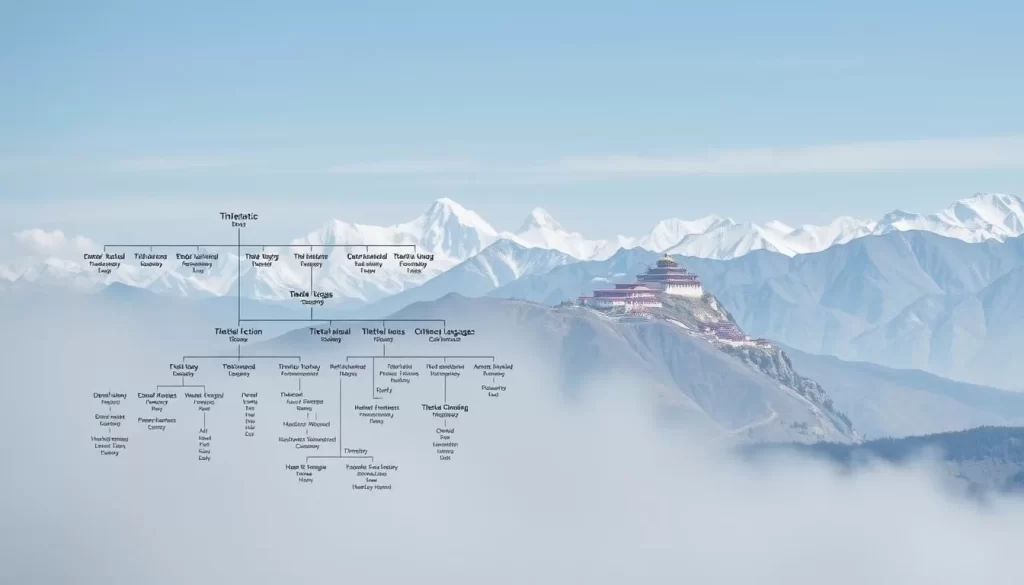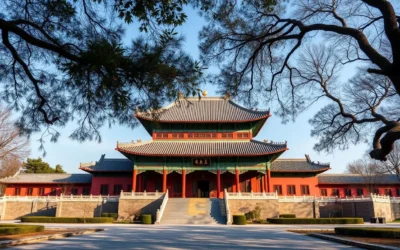✓ Accommodations✓ Flights✓ Rental Cars
Nestled in the northeast part of the country, this area is a melting pot of culture and history. Its diverse communities are united by a shared linguistic heritage. The region is home to a variety of dialects, each with its own unique charm and significance.
With over 200 dialects recognized, the linguistic landscape is both rich and complex. These dialects are part of the Tibetic language family, which includes around 50 distinct forms. The area’s history is deeply intertwined with its language, as seen in ancient texts and inscriptions.
The region’s population, which stands at approximately 3.6 million, reflects this diversity. About 86% of the people belong to the Tibetan ethnic group, contributing to the preservation of their native tongue. This linguistic richness plays a crucial role in education and community bonding.
As you delve deeper, you’ll discover how these languages have evolved over time. From classical forms to modern dialects, each has a story to tell. This article will guide you through the fascinating world of these linguistic treasures.
Introduction to Tibet’s Linguistic Diversity
The linguistic diversity of this high-altitude area is as vast as its landscapes. With over 200 dialects recognized, the region’s languages form a complex yet fascinating tapestry. These dialects belong to the Tibetic language family, which includes around 50 distinct forms.

Geographical and Historical Context
This area’s geography has played a key role in shaping its languages. The vast plateau and diverse topography have influenced how dialects spread and evolved. Isolation has helped preserve ancient forms, which continue to impact modern speech.
Historical texts and inscriptions reveal how language has been central to the region’s identity. For example, the spread of Tibetan Buddhism has deeply influenced linguistic traditions. This interplay between language and culture remains strong today.
Cultural Significance of Language in Tibet
Language is more than just a means of communication here. It’s a cornerstone of cultural identity. Traditional songs, stories, and religious texts are passed down through generations, keeping ancient dialects alive.
Research shows that bilingual education has become a vital tool for preserving these languages. Despite challenges, communities are working to ensure their linguistic heritage thrives. This effort highlights the enduring connection between language and regional pride.
Historical Evolution of the Tibetan Language
From its earliest forms to modern dialects, the Tibetan language has undergone fascinating transformations. Its journey reflects the region’s dynamic history and cultural exchanges. Let’s explore how this language evolved over time.

Early Forms and Classical Tibetan
The roots of the Tibetan language stretch back to the 7th century. The first version, known as Old Tibetan, was standardized in 816 AD under Emperor Sadnalegs. This early form laid the foundation for Classical Tibetan, which emerged as a literary language.
Classical Tibetan became central to religious scriptures, especially with the translation of Sanskrit texts by figures like Yijing and Xuanzang. These translations enriched the language, blending it with Buddhist teachings and philosophy.
“The adoption of Sanskrit texts marked a turning point in the evolution of Tibetan writing and thought.”
Language Shifts Through the Centuries
Over the centuries, the Tibetan language experienced significant shifts. By the 9th century, Old Literary Tibetan was used as a lingua franca by non-native speakers, including Han and Khotanese. This widespread use helped standardize the language across the region.
Phonological changes, such as tonogenesis and cluster simplifications, began around the 10th century. These shifts transformed how the language was spoken, leading to the modern dialects we know today.
| Period | Key Developments |
|---|---|
| 7th Century | Emergence of Old Tibetan |
| 9th Century | Old Literary Tibetan as lingua franca |
| 10th Century | Phonological shifts and tonogenesis |
These changes were not just linguistic but also cultural. The Tibetan script, established in the 630s and 640s AD, became a cornerstone of the region’s identity. Today, the language continues to evolve, preserving its rich heritage while adapting to modern times.
Tibet Autonomous Region, China: Official and widely spoken languages
Understanding the difference between official and widely spoken languages helps you appreciate the region’s linguistic richness. This area is home to a variety of dialects, each with its own cultural significance. While some are officially recognized, others thrive in everyday communication.

Defining Official Versus Widely Spoken Languages
Official languages are those recognized by the government for administrative and educational purposes. In this region, the Tibetan language holds this status, alongside Mandarin. These languages are used in schools, media, and official documents.
Widely spoken languages, on the other hand, include local dialects used by communities in daily life. These dialects may not have official status but are vital for cultural identity. For example, in rural areas, local dialects are often the primary means of communication.
Government policies play a key role in distinguishing between standardized languages and local dialects. Urban areas tend to use official languages more frequently, while rural communities preserve their native forms. This balance reflects the region’s diverse linguistic landscape.
The status of a language also impacts education. Bilingual programs often include both official and local dialects. This approach helps preserve cultural heritage while ensuring access to broader opportunities.
| Aspect | Official Languages | Widely Spoken Languages |
|---|---|---|
| Usage | Government, education, media | Daily communication, cultural events |
| Recognition | Legally recognized | Community-driven |
| Examples | Tibetan, Mandarin | Local dialects |
Cultural preservation is another critical factor. Official languages help unify the region, while local dialects maintain unique traditions. This dual approach ensures that both administrative needs and cultural heritage are met.
Classification and Distribution of Tibetic Languages
The Tibetic languages form a fascinating branch of the Sino-Tibetan family, rich in diversity and history. These languages are spoken across multiple countries, including China, India, Nepal, and Bhutan. Their classification and distribution reveal a complex tapestry of dialects and cultural connections.

Sino-Tibetan Connections and Subgrouping
The Tibetic languages are part of the larger Sino-Tibetan family, which includes over 400 languages spoken by billions of people. Within this family, Tibetic languages are grouped into several major dialects, such as Central Tibetan, Amdo, and Khams. These subgroups share common roots but have evolved distinct characteristics over time.
Linguists like Tournadre have identified specific criteria to differentiate these dialects. For example, phonological variations and lexical differences help classify them into distinct continua. This subgrouping highlights the linguistic richness of the Tibetic family.
The Dialect Continua of Tibetic Languages
The Tibetic languages are spread across a vast geographical area, creating a dialect continuum. This means that neighboring dialects are mutually intelligible, while those farther apart may not be. For instance, Central Tibetan and Amdo are distinct but share some common features due to historical contact.
Historical language contact has also played a role in shaping these dialects. Influences from Sinitic, Mongolic, and Indo-Aryan languages have contributed to their diversification. This interplay of languages has created a unique linguistic landscape.
- Central Tibetan: Spoken in the central regions, it serves as a lingua franca for many speakers.
- Amdo: Found in the northeastern areas, it retains many archaic features.
- Khams: Spoken in the southeastern regions, it shows influences from neighboring languages.
Understanding these dialect continua helps you appreciate the linguistic diversity of the Tibetic languages. Their spread across borders and regions underscores their cultural significance.
Writing Systems and Scripts in Tibet
The writing systems of this region reflect a deep connection to its cultural and historical identity. These scripts are not just tools for communication but also symbols of heritage and pride. Let’s explore how these systems evolved and adapted over time.
The Tibetan Script and Its Historical Roots
The Tibetan script traces its origins to the 7th century, attributed to Thönmi Sambhoṭa during the reign of Songtsän Gampo. Inspired by Indian alphabets, it was designed to translate Buddhist texts and preserve religious teachings. This script has remained remarkably consistent, maintaining its conservative orthography for centuries.
Over time, the script evolved into three main periods: Old Tibetan, Classical Tibetan, and Modern Tibetan. Each phase reflects changes in grammar, spelling, and usage, yet the core structure has endured. This continuity highlights its importance in preserving the language and culture.
“The Tibetan script is more than a writing system; it’s a bridge to our past and a guide for our future.”
Adoption of Devanagari and Urdu Scripts
In regions like India and Pakistan, alternative scripts such as Devanagari and Urdu are used to write Tibetic languages. These adaptations stem from cultural and political influences, ensuring the language remains accessible to diverse communities.
For example, in Baltistan, the Perso-Arabic (Urdu) script is widely used. This adoption reflects the region’s historical ties and the need for linguistic flexibility. Similarly, Devanagari is employed in parts of India, blending local traditions with Tibetan heritage.
| Script | Region | Cultural Significance |
|---|---|---|
| Tibetan | Central Areas | Preserves ancient texts and religious teachings |
| Devanagari | India | Integrates local and Tibetan traditions |
| Urdu | Baltistan | Reflects historical and political influences |
These multiple writing systems demonstrate the adaptability of the Tibetic language. They ensure its survival across borders and generations, enriching its cultural legacy. To learn more about the Tibetan script, explore its history and usage in detail.
Impact of Political and Cultural Shifts on Language
Political and cultural shifts have profoundly shaped the linguistic landscape of this region. These changes have influenced how people communicate, learn, and preserve their heritage. Let’s explore how policies and cultural resilience have impacted the language spoken here.
Influence of Chinese Educational and Ethnic Policies
Educational reforms have significantly affected the use of local dialects. Since the 1960s, Chinese has been the primary medium of instruction in schools, with Tibetan being taught only in specific classes. This shift has created tensions between preserving cultural identity and adapting to state policies.
In 2010, a bilingual education policy was introduced, but without clear guidelines, it often prioritized Chinese over local languages. By 2020, 80% of children were expected to attend Chinese-medium kindergartens, further marginalizing Tibetan in early education.
Teachers also reflect this shift. In 2017, 30% of educators in one Lhasa county reportedly did not know Tibetan. This lack of speakers in educational roles has made it harder for communities to pass down their linguistic heritage.
Cultural Resilience in the Tibetan Diaspora
Despite these challenges, the Tibetan diaspora has shown remarkable resilience. Communities abroad have established schools and cultural centers to teach their language and traditions. This effort ensures that younger generations stay connected to their roots.
Protests against Chinese-medium education have also highlighted the importance of linguistic preservation. In 2016, a person advocating for Tibetan education was sentenced to five years in prison. Such acts of resistance underscore the deep cultural significance of the tibetic language.
For more insights into how these policies impact language preservation, explore this detailed analysis.
| Policy | Impact |
|---|---|
| Bilingual Education | Marginalizes Tibetan in schools |
| Teacher Recruitment | Reduces Tibetan-speaking educators |
| Diaspora Efforts | Preserves language through cultural centers |
These examples illustrate the dynamic interplay between politics, education, and cultural preservation.
Educational and Social Implications for Tibetan Communities
Education plays a vital role in shaping the future of Tibetan communities. It serves as a bridge between preserving cultural heritage and adapting to modern demands. The language used in schools is a key factor in this balance, influencing how younger generations connect with their roots.
Bilingual Education and Language Preservation
Bilingual education has become a cornerstone for maintaining Tibetan identity. Programs that teach both Tibetan and Chinese aim to preserve the dialect while preparing students for broader opportunities. However, challenges persist in ensuring equal emphasis on both languages.
In rural areas, where Tibetan is the primary language, schools often struggle with limited resources. Many families cannot afford to send their children to school, leading to low enrollment rates. This creates a gap in access to quality education, especially for those who rely on their native dialect.
Despite these challenges, community-led initiatives are making a difference. Local groups are working to establish schools and cultural centers that focus on Tibetan language and traditions. These efforts ensure that the tibetic language remains a living part of daily life.
Challenges Facing Modern Tibetan Schools
Modern Tibetan schools face unique challenges in balancing tradition and policy. The shift toward Chinese-medium instruction has reduced proficiency in Tibetan among students. This trend raises concerns about the long-term preservation of the dialect.
Dropout rates are notably high, exacerbated by inadequate resources and facilities. In some areas, schools have only one teacher, who may not be qualified to teach both languages. This limits educational opportunities and affects student performance.
Protests against bilingual education policies highlight the deep cultural significance of the Tibetan language. Communities are advocating for policies that support both linguistic and cultural preservation. For more insights into these challenges, explore this detailed analysis.
Conclusion
The linguistic landscape of this region is a testament to its rich cultural heritage. The language diversity, from ancient scripts to modern dialects, reflects a deep connection to history and identity. Each dialect carries unique stories, shaping the way communities communicate and preserve their traditions.
Despite challenges posed by political and social shifts, the resilience of these communities stands out. Efforts to maintain bilingual education and cultural practices highlight the importance of preserving linguistic identity. This balance between tradition and modernity ensures that the language remains a vital part of daily life.
Understanding the complexity of these dialects and scripts invites you to appreciate their historical significance. To explore more about this fascinating topic, visit this detailed resource. Let’s continue to celebrate and support the preservation of these linguistic treasures.
The above is subject to change.
Check back often to TRAVEL.COM for the latest travel tips and deals.






